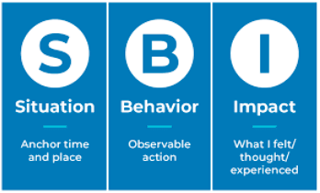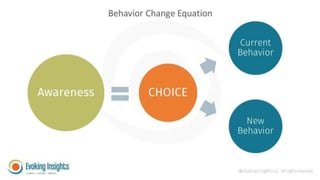When you look back over these last few years, have you grown as a leader? What has shifted in how you act or interact? What do you see or understand differently?
Most of us have grown and developed. But have we changed?
Do we ever really change? It’s a common question. On the one hand, “We are who we are.” And on the other, “Change is inevitable.”
A definition of change may provide some more insight:
Change: To alter, modify, …. or become different.
Changes that alter or modify are easier — like developing a new skill, or changing our look, maybe even our job.
But to become different… That is a whole different level of change. Transformational change.
A level of change that requires a shift, or expansion, in our sense of identity. Our sense of who we are and what we are capable of. Like becoming a game‑changing strategic leader.
Fundamentals of Change
My job as an executive coach is to facilitate behavior change. Just like your job as a strategic leader is to facilitate organizational change that positions the business for the future.
We need the same fundamentals to affect change in both experiences:
-
- A compelling case for behavior change. This is a mix of…
-
-
-
-
- Vision: Clear, compelling, and inspiring vision of your desired future state.
- Current reality: Awareness and acceptance of the way things are — the good, bad, and ugly.
-
-
-
-
- Actions and measures. To achieve the desired change, you must move from “here to there.”
- Obstacles and resistance to change. These invariably emerge along the way.
- Actions and measures. To achieve the desired change, you must move from “here to there.”
Creating a Case for Behavior Change
Over the last few years, I have actively embraced the wisdom of my emotions, something I once avoided. A colleague recently asked, WHY? Good question!
Where there is change, there must be a reason WHY things need to be different than today. What makes this change important, and why now?
For many leaders, myself included, the motivation is a desire for greater effectiveness and impact. While a powerful vision inspires direction, change is fundamentally catalyzed by a realization that the status quo is no longer an option. We change when the costs of not changing become painfully clear.
I was tired of feeling out of control, gripped by my emotions, and acting in ways that didn’t align with my values or vision for my leadership impact. When overly stressed, I automatically reverted to “silence” (withdrawn, vague, and avoidant) or “violence” (rigid, impatient, and judgmental). My effectiveness was compromised.
Urgency and momentum for behavior change build within the balance between:
“This is why I can’t stay where I am” and “This is where I am heading.”
Both are needed to navigate the inevitable obstacles, setbacks, and resistance that emerge. Without a compelling case for change, we simply revert to our old habits and ways of working — to the known and familiar. The discomfort and uncertainty of change alleviated.
Step 1: Envision the Change
It is easy to envision our desired leadership impact. For me, I look to leaders like Herb Kelleher (Southwest), Indra Nooyi (Pepsi), and Howard Shultz (Starbuck’s). Leaders that execute bold, disruptive strategies with a high level of alignment, commitment, and engagement.
Here’s where you create your bold leadership vision. You know, that B.H.A.G. … big, hairy, audacious, goal.
Pro Tip: The biggest challenge to our leadership vision is not our ability to create it. It is our belief—or lack thereof—that we are capable of becoming it.
What is your North Star? Do you have an aspirational statement that is ambitious, concise, and clear? As you craft your leadership vision, consider:
-
- A year from now, how will you have changed?
- What will become possible?
- Who will you have become as a leader?
Here is one client’s aspiration:
“To be a forward‑thinking leader who is able to envision, formulate, and successfully drive alignment to the future evolution of the organization”
Play around with the “Big‑V” and “little‑v” of vision. The first brings inspiration, the second more specificity of focus and action, a nearer‑term milestone toward that bigger vision.
My Big‑V Vision is bold and will take me years to truly become. My nearer-term “little‑v” was “to have emotions without my emotions having me.”
I would never become a bold strategic leader who leads with conviction and connection until I learned to effectively manage my stress responses to uncertainty, challenge, and risk of failure.
Step 2: Raise Your Awareness of What Is (Today)
Seems straightforward, right?
And yet … my coaching clients often point to their increased self‑awareness as one of the most transformational parts of the coaching experience — their increasing awareness of mindsets, beliefs, behaviors, and perspectives that were limiting their impact.
We can’t change what we can’t see ... or accept.
For the longest time, I didn’t really see or accept those “Silence” or “Violence” behaviors of my reactive self — the sides of me that show up when fear, uncertainty, or doubt have me in their grip. I was in a state of denial. It was too painful to own these behaviors. Especially when I felt powerless to change them — “I am who I am.” So instead, they owned me.
When we ignore, deny, minimize, or rationalize the way things are, we are destined to stay right where we are. We are our own biggest obstacle.
How do we see what we can’t see?
How do we see the “water we swim in?”
The easiest way to understand our impact on others is to ask. And yet …
According to the authors of Thanks for the Feedback, receiving feedback sits at the junction of two conflicting human desires: our desire to learn and grow, and our desire to be accepted and respected just as we are now. Change AND acceptance.
I was already stuck in the muck of my ineffective stress behaviors. The last thing I needed was my colleagues to reinforce what I already knew on some level. But what if they could offer feedback that would help me get un‑stuck? I connected to my WHY, my point of inspiration and motivation, to help prevent a spiral into feelings of criticism, rejection, and inadequacy. 
Then I solicited actionable, specific, and timely feedback in service of my stated goal that felt helpful and empowering. Sometimes we need to help our feedback providers give effective feedback. Try leveraging the SBI™ feedback tool developed by the Center for Creative Leadership (CCL).
Pro Tip: With your clarity of vision, describe a behavior to your colleague — i.e., “I want to be better at anticipating the future.” Ask your colleague: “What would you have me do more of? less of? to increase my effectiveness in this area.” Your sole purpose is to listen and understand. You can decide later what suggestions you find valuable for your purpose and intend to implement.
Step 3: Experiment from Here to There, aka The Actual Experience of Change
This is where the rubber meets the road. Just like strategy, this is where we align long‑term direction with near‑term action.
We need specificity of action — in this case, tangible, observable behavioral goals. 
In the day‑to‑day, what new behaviors will you put into practice to achieve your desired leadership impact?
From there, change becomes a simple equation. Awareness creates a choice — new behavior, or old behavior?
On paper, my choice was as simple as speak up and clearly assert my perspective (if I was reacting in “Silence” mode) or get curious and listen (if I was reacting in “Violence” mode). Without awareness, there are only habitual ways of being.
And yet, exercising that choice‑point in the moment often feels hard, if not impossible. And hence, our question — “Do we ever really change?”
Pro Tip: Break down your desired behavior change into the next Situation. Avoid the “all or nothing” thinking of “I’ve changed” or not and just experiment with this new behavior. Scientists know the model of experimentation well. In this case, a hypothesis about how a new Behavior might result in increased Impact. It is a theory to test, not an outcome to deliver.
What if instead of rushing to the end result, we experimented our way into our future self?
With your list of desired behaviors from your leadership vision, identify a few Situations in the week ahead where you can experiment with a new Behavior for your desired Impact.
Then get curious.
When I thought of my desired shift as a series of experiments, I showed up with curiosity instead of judgment. I learned from each experiment, and momentum began to build. I found situations where it was easier to practice my curiosity (or assertiveness), and even situations where these behaviors naturally show up for me. The change no longer felt overwhelming.
A question I often ask my clients is, “What would it be like to be just 2% more [desired behavior] this week?” Universally, clients feel a release.
That’s because imagining 100% change = feeling stuck and overwhelmed.
Imagining 2% modified = “I can do that!”
So much more becomes possible when we shift to thinking of behavior change as a practice instead of as a goal to achieve, like a revenue number to hit.
And yes, any change requires an ability to see that shifts are happening. Behavior change isn’t as measurable as that revenue number, but it also isn’t that absolute. Behavior change is a process of becoming. One experiment at a time.
So, Are You Ready to Change?
What do you think? Are you ready to experiment your way into your future? Can you afford NOT to change?
A coaching engagement just ended, and here is what my client said:
“I confess, I really was skeptical at the beginning of this engagement. My leadership vision was clear, but I thought, ‘I am who I am.’ I really didn’t believe I could lead in this way. I am blown away by the process.”
We can change — if we are open to it.
How do you want to change or transform your behavior to become a more impactful leader? What are you willing to imagine and believe for yourself? What possibility is waiting for you?



